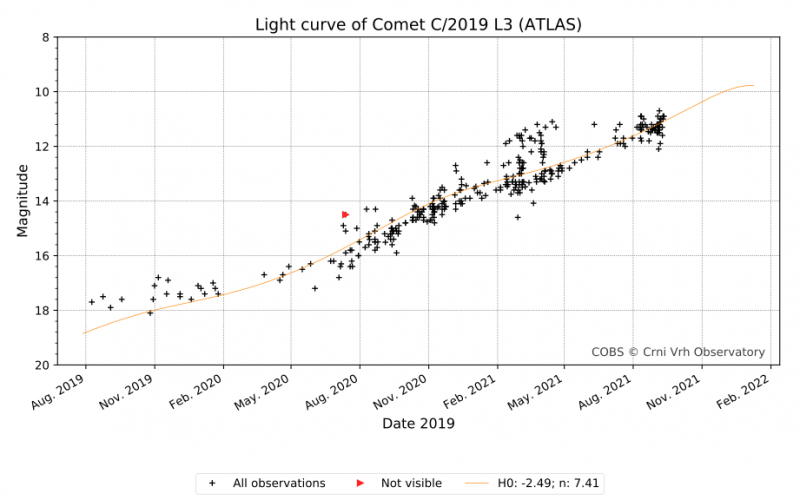2021 September 12
Comet of the month – C/2019 L3 (ATLAS)
This month’s comet of the month is C/2019 L3 (ATLAS). This is another comet that was discovered by a survey a long way out and it never gets very close to the Sun but it is one of the brightest comets around at the moment and it is very well placed for us as it heads in to perihelion in 2022 January.
The comet was discovered as an asteroidal object by the Asteroid Terrestrial-Impact Last Alert System (ATLAS). The discovery image on 2019 June 10 showed it as an 18th magnitude, apparently starlike, object moving very slowly in Lacerta. Its orbit was highly eccentric and it appeared to be cometary so it was placed on the Possible Comet Confirmation Page (PCCP). A number of observers then confirmed that it had a coma and the object was designated C/2021 L3 (ATLAS) on CBET 4644 issued on 2019 July 1.

The orbit showed that the comet would come to perihelion on 2022 Jan 9 but that the perihelion distance would only be 3.55 au. At discovery it was 8.5 au from the Sun and it is has now (2021 September) reached 3.7au and is brightening up quite nicely with a good tail. Martin Mobberley’s recent image here shows this well. It is slowly moving through Lacerta and Gemini as shown in this chart (2019l3.pdf) and it is ideally placed for us over the autumn and winter.
The COBS lightcurve shows that the comet is already around 11th magnitude and it may reach magnitude 10 over the winter as it moves slowly through Gemini. It will pass around a degree from the globular NGC2419 on 2021 November 20 and very close to the open cluster NGC2266 on 2020 Jan 30.

Images of the comet can be found in the section archive here. The first image is this one from Eric Bryssinck shortly after discovery 2019 June 22. The image here is from Denis Buczynski taken on 2021 September 8.

Please send any observations to the Comet Section.
| The British Astronomical Association supports amateur astronomers around the UK and the rest of the world. Find out more about the BAA or join us. |
